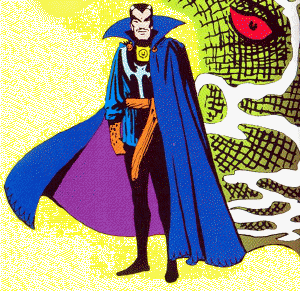
The indomitable Doctor Strange, as drawn by
the inimitable Steve Ditko (from Strange Tales #118.)
Welcome to the Weird Worlds
of...
Doctor Strange

The indomitable Doctor Strange, as drawn by
the inimitable Steve Ditko (from Strange Tales #118.)
Dr. Strange made his first appearance forty years ago this month in July, 1963, in Marvel Comic's Strange Tales (#110.) From the very beginning, he seemed a unique and off-beat addition to the newly-assembling
pantheon of Marvel superheroes. Dr. Strange did not employ physical strength or scientific gadgetry to battle his foes as did other Marvel characters. He wielded magic and his powers were purely occult in nature. This actually makes Dr. Strange a very early forerunner of the so-called "occult explosion" of the late 1960's. Before best-selling novels like Rosemary's Baby and The Exorcist ignited popular interest in magic, witchcraft and the supernatural, Marvel fans were enjoying the esoteric adventures of Dr. Strange.
Dr. Strange was conceived by Stan Lee, the legendary mastermind of Marvel Comics. His early exploits were drawn by the incomparable Steve Ditko, originally of Johnstown, PA, who illustrated many of the titles in Marvel's rapidly growing line-up. One must wonder why Lee came up with a character so different from Marvel's other superheroes. Perhaps the huge interest American kids were showing at that time in Famous Monsters of Filmland, an immensely popular magazine devoted to cinematic horror and fantasy, convinced Lee to dabble in the supernatural.Dr. Strange began his career as a sort of "occult detective" in the manner of Jules deGrandin, a supernatural adventurer and bon vivant created by Seabury Quinn who appeared in a total of 93 stories in Weird Tales from 1925 through 1951. In 1908, Algernon Blackwood supplied an even earlier prototype for Dr. Strange with a character named John Silence, also a doctor, whose financial independence and philanthropic temperament enabled him to utilize his vast esoteric knowledge for the benefit of supernaturally plagued individuals. The very first Dr. Strange tale presents a plot right out of a John Silence story: Marvel's Master of the Mystic Arts is approached by a desperate man needing help with a recurring dream. We quickly learn that astral projection and the ability to enter other people's dreams are two of the powers of the esoterically talented Dr. Strange:
Doctor Strange inducing an out of the body experience, as drawn by
the legendary Steve Ditko (from Strange Tales #110.)
Although his first episode portrayed him as a somewhat remote, aloof mystic to whom others occasionally appealed for help, the role of Dr. Strange expanded as he continued to make appearances in Strange Tales, and he finally emerged as an active participant in the ongoing occult battle between the Forces of Light and Darkness. These pages will explore the world of Doctor Strange and attempt to explain his truly unique appeal. We will especially examine the metaphysical aspects of his various adventures, and try to connect the arcane theories and acts of magic that form a major part of his tales with their deeper roots in actual occult theory and practice. For now, you can learn more about Astral Projection, just one of the powers of Doctor Strange, by clicking the link below.
The Powers of Doctor Strange
Astral Projection
You can also read about my own strange personal experiences with psychic phenomena by clicking here:
Check back over the next several weeks for updates and additions. Meanwhile, as you await new material to appear on these pages, check out these other great Doctor Strange sites:
The Dr. Strange Sanctum Sanctorum
Credits: Background Image from original drawing by Steve Ditko (in Strange Tales #110, July, 1963.) Kaleidoscoped by William Max Miller. Dr. Strange image (top of page) by Steve Ditko (from Strange Tales #115.) Dual panel showing Dr. Strange astrally projecting by Steve Ditko (from Strange Tales #110.) Weird Tales (Nov., 1937) cover art by Margaret Brundage. Strange Tales #110 cover art by Steve Ditko.
Return to Time's Seventh Tower